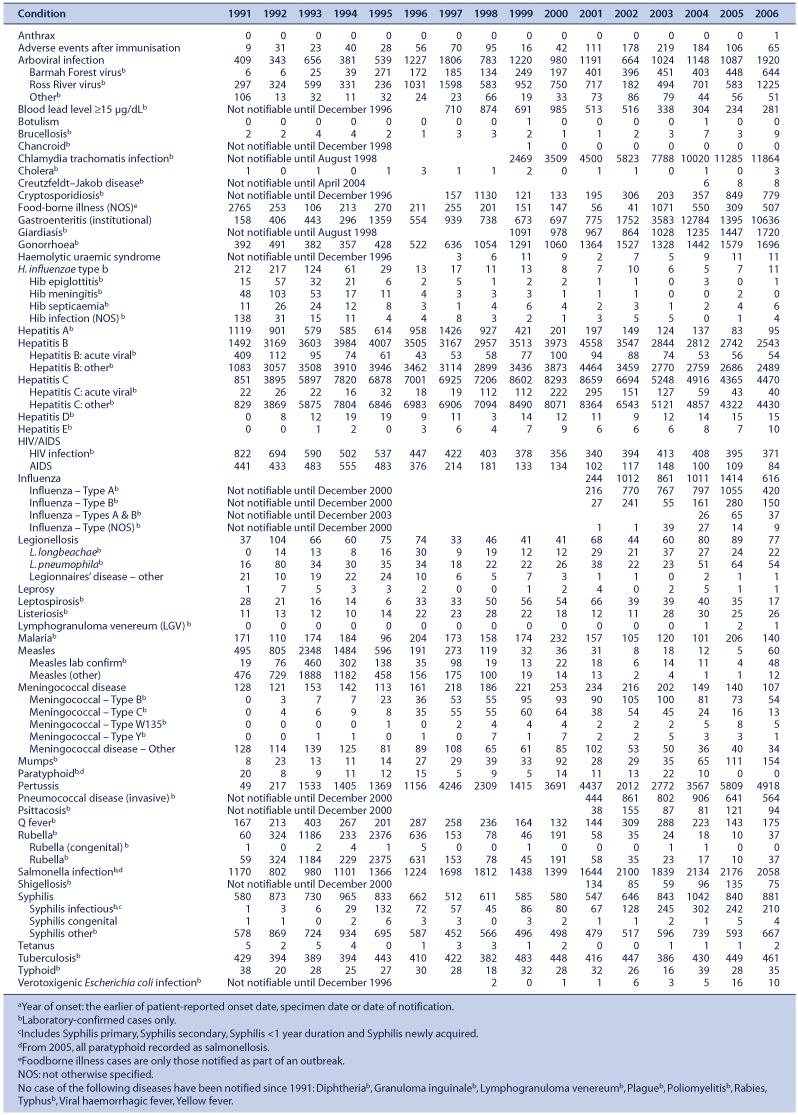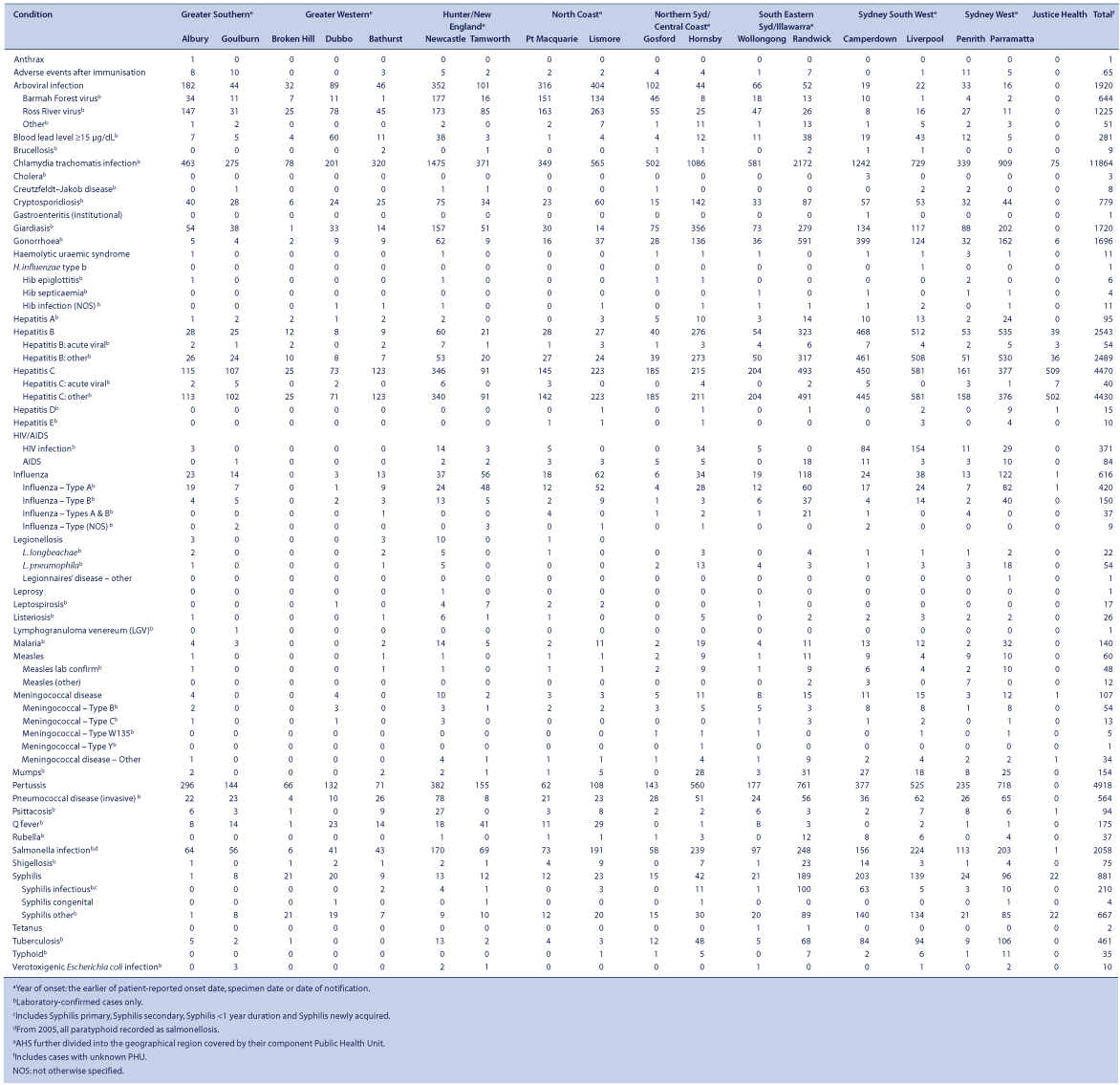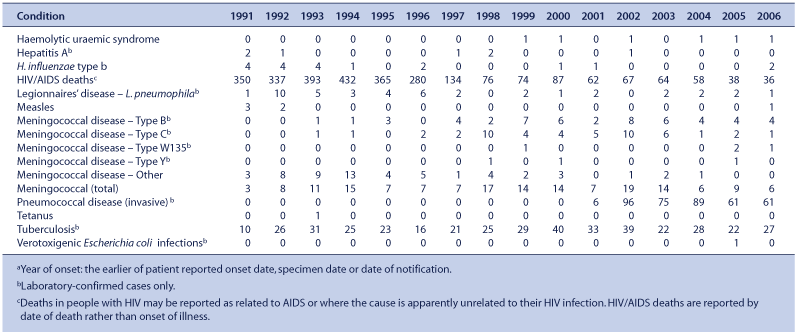Year in review: communicable disease surveillance, New South Wales, 2006
NSW Public Health Bulletin 18(8) 105-114 https://doi.org/10.1071/NB07096
Published: 27 August 2007
In this issue, we review the trends in reports of notifiable diseases among NSW residents received by the NSW Public Health Units (PHU) for 2006. Readers interested in the details of notifications for specific diseases are referred to Tables 1–5, where diseases are reported by: year of onset, month of onset, Area Health Service (AHS), age group and sex. Table 6 shows the number of people with selected notifiable conditions who were reported to have died at the time of follow-up by their local PHU.

|

|

|

|

|

|
Trends
Among the 47 608 NSW residents with medical conditions notified by doctors, hospital staff, and laboratory staff for 2006, highlights included:
Conditions most frequently reported
-
Chlamydia: 11 864 cases (173 per 100 000 people), with the highest crude rates by geographical area in the South Eastern Sydney/Illawarra (Randwick region), Hunter/New England (Newcastle region) and Sydney South West (Camperdown region) AHSs
-
Pertussis: 4918 cases (73 per 100 000 people), with the highest crude rates in the Greater Western (Broken Hill and Dubbo regions) and Greater Southern (Albury region) Health Areas. Note, a proportion of pertussis notifications may have been false-positive tests caused by the performance of a commonly used serology test kit (see http://www.health.nsw.gov.au/infect/pdf/false_pertussis_tests.pdf)
-
Hepatitis C: 4470 cases (65 per 100 000 people), with the highest crude rates in the Sydney South West (Camperdown region), North Coast (Lismore region) and Greater Western (Bathurst region) AHSs
-
Hepatitis B: 2543 cases (37 per 100 000 people), with the highest crude rates in the Sydney South West and Sydney West (Parramatta region) AHSs
-
Salmonella infections: 2058 cases (26 per 100 000 population), with the highest crude rates in the North Coast (Lismore region), Greater West (Dubbo region) and Hunter New England (Tamworth region) AHSs.
Conditions with the most meaningful declines in the number of notifications compared with previous years
-
Hepatitis B: 2543 cases, steadily declining from 4458 cases in 2001, with the most pronounced fall (43% since 2002) in the 35 to 44 year age group, possibly as a result of the ongoing impact of immunisation
-
Pneumococcal disease (invasive): 564 cases, a continued decline from 906 in 2004 and most pronounced in the 0-to-2-year age group, possibly a result of the inclusion of the pneumococcal vaccination on the universal childhood vaccination schedule in early 2005
-
Meningococcal disease: 107 cases, a continued decline from 253 in 2000, the lowest number of notifications since laboratory reporting began in 1991 and in part due to the introduction of meningococcal C vaccination in late 2003
-
Leptospirosis: 17 cases, down from 66 in 2001, the cause of the decline is unclear.
Conditions with the most meaningful increases in the number of notifications compared with previous years
-
Chlamydia: 11 864 cases, continuing its rise since it became notifiable in the late 1990s
-
Infectious syphilis: re-emerging as a significant issue in the gay community in late 2006
-
Barmah Forest virus infection: 644 cases, due to outbreaks mainly in coastal areas of rural NSW in early 2006
-
Ross River virus infection: 1225 cases, up from 583 in 2005, due to outbreaks across rural NSW in early 2006
-
Gastroenteritis in institutions: 10 636 cases associated with 436 outbreaks, mostly due to norovirus infections
-
Mumps: 154 cases, up from 111 in 2005, mainly in young adults and the highest number of laboratory notifications since laboratory reporting began in 1991
-
Legionnaires’ disease, due to infection with Legionella pneumophila: 54 cases, in part due to outbreaks in western and northern Sydney
-
Measles: 48 cases, due to two outbreaks, one in March 2006 related to contact at a hospital emergency department and the second, larger outbreak, in people associated with a national spiritual tour.
Note that the apparent increase in giardiasis (1720 cases) and verotoxigenic Escherichia coli infections (10 cases) are probably related to changes in laboratory testing practices resulting in a higher proportion of samples tested for these organisms than in the past.
Conditions least frequently reported
There were no reported cases of avian influenza, botulism, chancroid, diphtheria, donovanosis, granuloma inguinale, plague, polio, rabies/lyssavirus, SARS, smallpox, tularaemia, typhus, viral haemorrhagic fevers or yellow fever in NSW in 2006.
Conditions associated with the largest numbers of reported deaths
Deaths reported via the surveillance mechanisms for notifiable conditions may not include all deaths associated with these conditions. PHUs routinely investigate all cases of some notifiable conditions (eg, tuberculosis, measles, meningococcal disease) in order to implement control measures; the investigations are likely to identify associated deaths. However, there are other notifiable conditions (eg, chlamydia and gonorrhoea) where PHUs do not conduct routine investigations and for which deaths will not be identified as part of the notification or public health management process. Conversely, some deaths in patients following notification may be due to conditions other than that notified. Deaths were most frequently reported for the following notifiable diseases:
-
Invasive pneumococcal disease: 61 deaths
-
HIV infection: 36 deaths, including 13 people who died from AIDS, and 23 people with HIV infection who died of causes other than AIDS
-
Tuberculosis: 21 deaths.
Outbreaks and threats
Several notable disease outbreaks and threats were reported in 2006 in NSW. These included:
-
Outbreaks of Legionnaires’ disease in western Sydney in January 20061 and northern Sydney in March 20062 thought to be related to contaminated cooling towers.
-
Two outbreaks of measles2
-
An outbreak of keratoconjunctivitis in patients of an eye clinic in regional NSW in March 20062
-
Four cases of lymphogranuloma venereum identified in early 2006, the first cases in NSW3
-
A cluster of cases of Salmonella Saint-Paul infection in October 2006 linked to contaminated rockmelons4
-
Three cases of cholera in November 2006 linked to consumption of raw imported whitebait.5
Conclusions
Sexually transmitted infections, gastroenteritis (particularly norovirus) and arboviruses continue to be significant public health problems in NSW. Much progress has been made with other diseases, such as hepatitis B, invasive pneumococcal disease and meningococcal disease, in which declines were identified. Outbreaks of diseases, that have largely been brought under control, for example measles and mumps (where many young adults remain unvaccinated), continue to pose a threat.
We thank all those general and specialist medical practices, laboratories, hospitals, schools, child-care centres, and others, who have notified diseases of public health significance to their local PHUs for investigation and control.
[1] NSW Department of Health Communicable Diseases Report, NSW, for January and February 2006. N S W Public Health Bull 2006; 17(3–4): 58–9.
| Crossref | GoogleScholarGoogle Scholar | PubMed |

[2] NSW Department of Health Communicable Diseases Report, NSW, for March and April 2006. N S W Public Health Bull 2006; 17(5–6): 88–91.
| Crossref | GoogleScholarGoogle Scholar | PubMed |

[3] NSW Department of Health Communicable Diseases Report, NSW, for July and August 2006. N S W Public Health Bull 2006; 17(9–10): 154–5.
| Crossref | GoogleScholarGoogle Scholar | PubMed |

[4] NSW Department of Health Communicable Diseases Report, NSW, for September and October 2006. N S W Public Health Bull 2006; 17(11–12): 182–3.
| Crossref | GoogleScholarGoogle Scholar | PubMed |

[5] NSW Department of Health Communicable Diseases Report, NSW, for November and December 2006. N S W Public Health Bull 2007; 18(1–2): 28–32.
| Crossref | GoogleScholarGoogle Scholar | PubMed |


